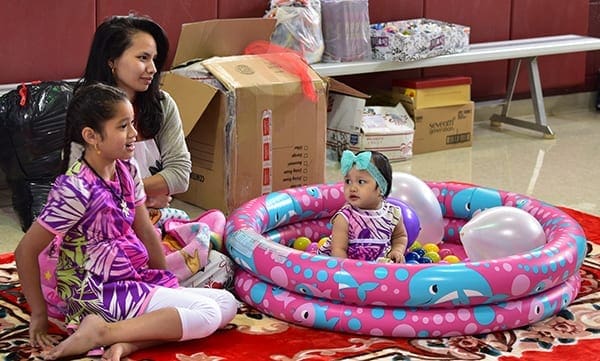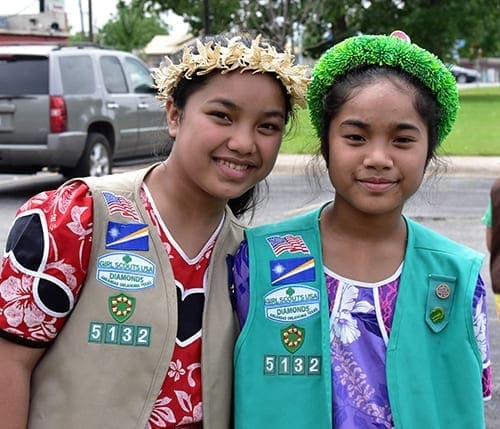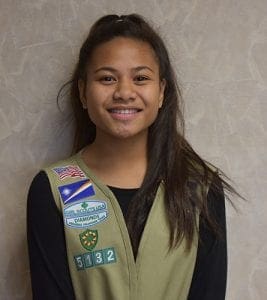From the Atolls to the Ozarks
Online ExhibitIntroduction
Rona Masha, guest curator

The Marshallese community’s many celebrations reflect our culture and traditions. We have adapted to life here in the Arkansas Ozarks which we have found to be very different from life in the chain of islands called atolls which form the Republic of the Marshall Islands, west of Hawaii. We have Americanized our traditional dress and we prepare our traditional food using local substitutions. We have adapted to the English language, making both Marshallese and English our official languages. Other adaptions include adjusting our time management for school and work.
Our migration from the atolls to the Ozarks began when John Moody moved to the United States to go to college. He came looking for education and for a new home because of the damage done to the Islands between 1946 and 1958, when the United States conducted sixty-seven nuclear tests on or near Bikini and Enewetak Atolls. Because of this damage, the U.S. made a Compact of Free Association with the Marshallese, letting them come here to begin a new life. Around 1986 Mr. Moody moved to Springdale to work for Tyson Foods. He married a local woman and told family and friends of the opportunities here in Northwest Arkansas. Many came to live and work here. Today Springdale is home to the largest Marshallese community outside of the Islands. Even though we have new challenges to adjust to, we still hold on to tradition, family, religion, and respect.

Kemem—The Kabua family celebrating Tamiko’s first birthday, May 2016. Courtesy Heather Butler and Kay Dye, photographers
A few of the events we love to celebrate are Palm Sunday, Combine, Kemem, and May Day/Jemenei (Constitution) Day.
Palm Sunday is one of the many holy days that we celebrate. We come together for prayer, worship, eating, and singing and dancing.
The Combine is a time when Marshallese church groups from all over the United States—and even the Marshall Islands—come together for worship. We honor our dignitaries with marmars (leis or necklaces), sing and dance, and give away clothing and other gifts.
Kemem celebrates a baby’s first birthday. The nuclear tests affected the health of the Marshallese. Because of the radiation from the bombs it was rare for a baby to survive its first year of life. When a child reached its first birthday, the family had a great celebration to show gratitude for their child’s achievement.
May Day/Jemenei (Constitution) Day acknowledges the day our constitution was signed on May 1, 1979, our first step towards independence as a nation. We celebrate with parades, speeches, pageants, sports competitions, and, as always, lots of food.
During our celebrations you will see us acknowledge the important people in our community such as pastors and their wives, sponsors, and those who help the Marshallese community politically. We always start our events with prayer. Our food is typically barbequed chicken and rice along with other side dishes. We have special performances where we do praise dances called biit (pronounced “beat”) and sing songs from the Buk in Al (Book Hymnal) or just songs in English or Marshallese. People are usually dressed in special clothing we call “uniforms.” These matching shirts and dresses are made of fabric from Hawaii with a bright, island-style print.

Jemenei Day—Tabitha Kerong (left) wears a traditional wut (headband) while her sister Anna wears a modern adaptation, May 2016. Courtesy Heather Butler and Kay Dye, photographers
The Ozark adaptions that we make for our celebrations are reflected in our uniforms, wuts (a wut is a headband; pronounced “woot”), and food. In the Islands our dress was plain and simple, but in the Ozarks our uniforms are modern and updated, designed with more sparkles and sequins. But now the influence of our new culture has changed our dress in the Islands to this modern style. Wuts have gone from being handwoven from pandanus and coconut tree fibers to being made from things like artificial flowers. The leis which we use to honor our special guests have changed like our wuts and can include modern materials. Our food is different from the traditional food because we don’t have the same ingredients. In the Islands our food comes from the natural resources all around us like fresh fish, breadfruit, and coconut, but in the Ozarks most food is store-bought. The dishes may not taste exactly the same, but they are still great.
I have presented this information about Marshallese celebrations with great honor and respect for my culture. I hope you will share in knowing how important our culture is to us, as I believe all people’s cultures should be honored, celebrated, and remembered. For we, the Marshallese community, have traveled here to settle in the Ozarks, bringing our culture, respect, families, religion, and traditions.
Introduction
Rona Masha, guest curator

The Marshallese community’s many celebrations reflect our culture and traditions. We have adapted to life here in the Arkansas Ozarks which we have found to be very different from life in the chain of islands called atolls which form the Republic of the Marshall Islands, west of Hawaii. We have Americanized our traditional dress and we prepare our traditional food using local substitutions. We have adapted to the English language, making both Marshallese and English our official languages. Other adaptions include adjusting our time management for school and work.
Our migration from the atolls to the Ozarks began when John Moody moved to the United States to go to college. He came looking for education and for a new home because of the damage done to the Islands between 1946 and 1958, when the United States conducted sixty-seven nuclear tests on or near Bikini and Enewetak Atolls. Because of this damage, the U.S. made a Compact of Free Association with the Marshallese, letting them come here to begin a new life. Around 1986 Mr. Moody moved to Springdale to work for Tyson Foods. He married a local woman and told family and friends of the opportunities here in Northwest Arkansas. Many came to live and work here. Today Springdale is home to the largest Marshallese community outside of the Islands. Even though we have new challenges to adjust to, we still hold on to tradition, family, religion, and respect.

Kemem—The Kabua family celebrating Tamiko’s first birthday, May 2016. Courtesy Heather Butler and Kay Dye, photographers
A few of the events we love to celebrate are Palm Sunday, Combine, Kemem, and May Day/Jemenei (Constitution) Day.
Palm Sunday is one of the many holy days that we celebrate. We come together for prayer, worship, eating, and singing and dancing.
The Combine is a time when Marshallese church groups from all over the United States—and even the Marshall Islands—come together for worship. We honor our dignitaries with marmars (leis or necklaces), sing and dance, and give away clothing and other gifts.
Kemem celebrates a baby’s first birthday. The nuclear tests affected the health of the Marshallese. Because of the radiation from the bombs it was rare for a baby to survive its first year of life. When a child reached its first birthday, the family had a great celebration to show gratitude for their child’s achievement.
May Day/Jemenei (Constitution) Day acknowledges the day our constitution was signed on May 1, 1979, our first step towards independence as a nation. We celebrate with parades, speeches, pageants, sports competitions, and, as always, lots of food.
During our celebrations you will see us acknowledge the important people in our community such as pastors and their wives, sponsors, and those who help the Marshallese community politically. We always start our events with prayer. Our food is typically barbequed chicken and rice along with other side dishes. We have special performances where we do praise dances called biit (pronounced “beat”) and sing songs from the Buk in Al (Book Hymnal) or just songs in English or Marshallese. People are usually dressed in special clothing we call “uniforms.” These matching shirts and dresses are made of fabric from Hawaii with a bright, island-style print.

Jemenei Day—Tabitha Kerong (left) wears a traditional wut (headband) while her sister Anna wears a modern adaptation, May 2016. Courtesy Heather Butler and Kay Dye, photographers
The Ozark adaptions that we make for our celebrations are reflected in our uniforms, wuts (a wut is a headband; pronounced “woot”), and food. In the Islands our dress was plain and simple, but in the Ozarks our uniforms are modern and updated, designed with more sparkles and sequins. But now the influence of our new culture has changed our dress in the Islands to this modern style. Wuts have gone from being handwoven from pandanus and coconut tree fibers to being made from things like artificial flowers. The leis which we use to honor our special guests have changed like our wuts and can include modern materials. Our food is different from the traditional food because we don’t have the same ingredients. In the Islands our food comes from the natural resources all around us like fresh fish, breadfruit, and coconut, but in the Ozarks most food is store-bought. The dishes may not taste exactly the same, but they are still great.
I have presented this information about Marshallese celebrations with great honor and respect for my culture. I hope you will share in knowing how important our culture is to us, as I believe all people’s cultures should be honored, celebrated, and remembered. For we, the Marshallese community, have traveled here to settle in the Ozarks, bringing our culture, respect, families, religion, and traditions.
Some Artifacts from the Exhibit

RELIGIOUS BOOKS—Jeje Ko Rekkwojarjar (Spiritual Writings of the Bible) and Buk in Al Kab Tun Ko (Book Hymnal of Songs) used by the Masha family at Anij Emman Church, Springdale. The latter contains traditional Christian hymns translated into Marshallese.
WUT (Headband)—Wuts are headbands worn by women and girls. They are often made of plant fibers like coconut and pandanus and can be decorated with colored fringe, cowry shells, or woven flowers. Some wuts show a modern influence, using synthetic elements like Koosh® balls (seen here).
WOTJE (Ear Rose)—These small flowers are presented as gifts to women and young ladies. They are worn on the ear and come in many colors to match the wearer’s outfit.
DEEL (Fan)—These fans are made from shredded, dyed, and plaited (woven) pandanus leaves. They are used to tap out a rhythm in traditional Marshallese dances and as fans for cooling.
MARMAR (Necklace or Lei)—Money leis are given to honored guests at celebrations and to pastors at church services. They are made of ten one-dollar bills taped together. Flower leis are usually given to guests of honor, to those who have helped with a celebration, or to recognize special accomplishments like school graduations. Candy leis are often given to men and children. They may be homemade (left) or commercially made and imported from Hawaii (right).
Items courtesy of Heather Butler, Sandy Hainline-Williams, and the Masha Family.

KEMEM T-SHIRT—Worn by a young guest at the celebration of Malachi Marty’s first birthday, Springdale, 2016.
CLOTH—The members of a Marshallese church often wear matching “uniforms” during special celebrations and events. After a color and pattern have been selected, bolts of fabric are shipped from Hawaii. Each family gets a length of cloth to turn into dresses for women and girls and shirts for men and boys. By using the same fabric, a congregation’s clothing looks similar, but each family’s seamstress adds design elements such as ruffles, banding, and inset fabrics to make the uniforms unique to her family.
SHIRT and DRESS—Jepta uniforms worn by Yotina and Jacob Masha, Springdale, December 2008. Jeptas are teams that form in the months before Christmas. They learn new songs and dances for a fun-filled competition held on Christmas Day.
DRESS—Made by Esry Samuel for her granddaughter, Rona Masha, Springdale, 2016. Sequins, rhinestones, and sparkly fabrics demonstrate a modern influence on a traditional-style dress.
FLAG-DANCE DRESS—Made by Jola Kaious and worn by a contestant in the Miss Jemenei Day pageant, Springdale, May Day, 2016. Dresses like this one are worn during special events to perform the traditional Marshallese Flag Dance.
JAKI (Mat)—Made from pandanus leaves which are shredded and woven together. Mats are used to sleep on and to sit on when eating a meal.
Items courtesy of Marshallese Consulate General Carmen Chong-Gum, Sandy Hainline-Williams, Joe Kaminaga, the Masha Family, and the Dr. Joseph Bates Outreach Clinic Arkansas Department of Health.
 Rona Masha was a ninth-grader living in Springdale when she created this exhibit in 2016. She was a member of Girl Scout Troop #5132, the only Marshallese troop within the organization. For her 2016 Silver Award project, the first ever for a Marshallese Scout, Rona created this exhibit to acknowledge the Marshallese community and the unique celebrations that occur throughout her life.
Rona Masha was a ninth-grader living in Springdale when she created this exhibit in 2016. She was a member of Girl Scout Troop #5132, the only Marshallese troop within the organization. For her 2016 Silver Award project, the first ever for a Marshallese Scout, Rona created this exhibit to acknowledge the Marshallese community and the unique celebrations that occur throughout her life.
The Silver Award is the second-highest award a Girl Scout can achieve. The award signifies the Scout’s involvement with the community and identifies her as a girl who can finish what she starts. Being engaged with the community develops personal growth for one who sets her standards high.
This project was a pleasure for Rona to direct and an honor to represent the Marshallese community. She believes all cultures and their celebrations are to be valued. She is grateful to the Springdale community and the Shiloh Museum for giving her this once-in-a-lifetime opportunity.
 Rona Masha was a ninth-grader living in Springdale when she created this exhibit in 2016. She was a member of Girl Scout Troop #5132, the only Marshallese troop within the organization. For her 2016 Silver Award project, the first ever for a Marshallese Scout, Rona created this exhibit to acknowledge the Marshallese community and the unique celebrations that occur throughout her life.
Rona Masha was a ninth-grader living in Springdale when she created this exhibit in 2016. She was a member of Girl Scout Troop #5132, the only Marshallese troop within the organization. For her 2016 Silver Award project, the first ever for a Marshallese Scout, Rona created this exhibit to acknowledge the Marshallese community and the unique celebrations that occur throughout her life.
The Silver Award is the second-highest award a Girl Scout can achieve. The award signifies the Scout’s involvement with the community and identifies her as a girl who can finish what she starts. Being engaged with the community develops personal growth for one who sets her standards high.
This project was a pleasure for Rona to direct and an honor to represent the Marshallese community. She believes all cultures and their celebrations are to be valued. She is grateful to the Springdale community and the Shiloh Museum for giving her this once-in-a-lifetime opportunity.
